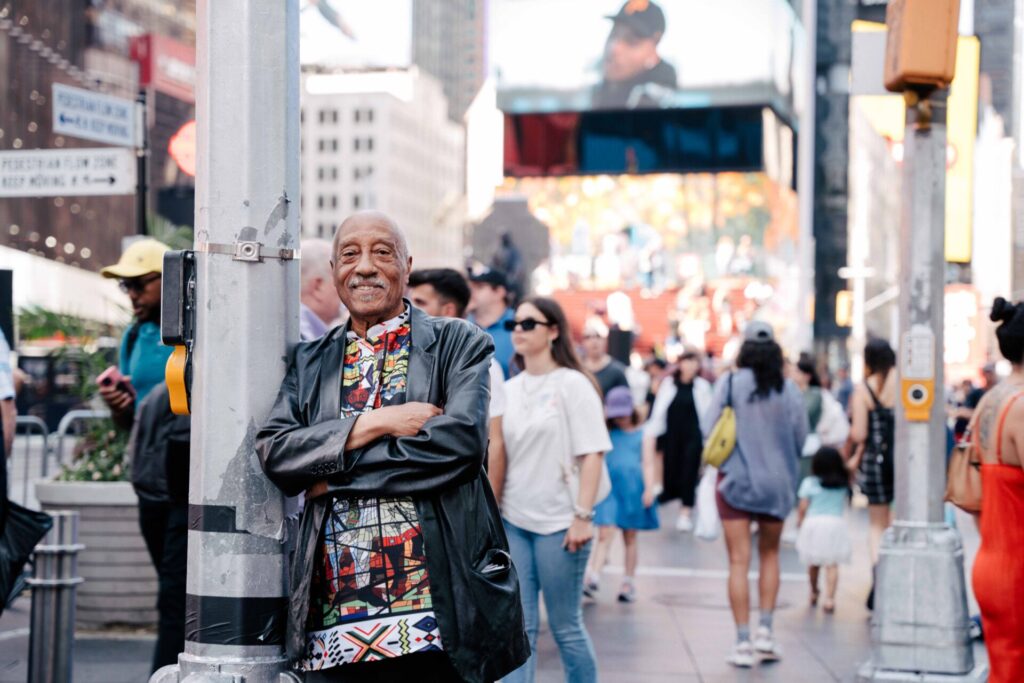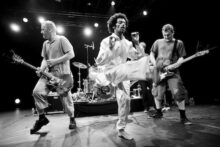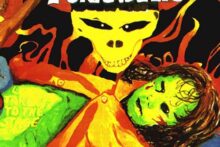In Hindu cosmology, the world is traditionally depicted as a dome resting on the backs of four strong elephants, who themselves stand on the shell of a giant tortoise. In the traditional music of the Ethiopian Highlands there are four sturdy modes which support the country’s distinctive modal musical system called Qiñit; and they are tezeta, bati, ambassel, and anchihoy. And so fundamental are they to the Ethiopian sound that they often fully or partially make up song names. You can spot them cropping up time and again in the titles of songs written by the founder of Ethio jazz, Mulatu Astatke.
The traditional music of Ethiopia experienced successive waves of revival during the 20th century, with the most powerful taking place in the late 1960s. Astatke was in an ideal position to ride and then, to a certain extent, guide those waves. He was born in Jimma in 1943, left home to further his musical education in Wrexham and London, before moving to the States to study vibraphone and percussion at Berklee College of Music, Boston. He returned home, moving to Addis Ababa bringing a keenness to experiment with form and texture back with him; although non-Ethiopian flavours such as Latin jazz may have become an undeniable influence, the music of his home country remained his lodestar.
Prior to the release of his new studio album, Mulatu Plays Mulatu, the composer ponders his journey – from honing his musicianship in London to finding his own voice in Boston and setting the trend in the swinging Addis as well as around the globe. “I was always thinking about these people – Miles Davis, Charlie Parker – how they became what they are now”, Mulatu recalls today. “I was thinking how come I haven’t become like them, so eventually I developed Ethio jazz and became myself.”
His upcoming release is yet another evidence of the artist’s influence and all-inclusive nature of his music bridging disparate cultures. After a series of recording sessions in London. Astatke went back to Addis Ababa, where these tracks were augmented with traditional instruments. Hence, increasing the audible contrast between Western and Eastern sounds. Take, for example, ‘Nètsanèt’ (meaning Freedom), first widely available on the 1974 compilation album Ethio Jazz = የካተት featuring Fekade Amde Maskal: the original version is undeniably written in an Ethiopian mode but is textually indebted to the sizzling psychedelic soul of The Headhunters, Funkadelic and War, while the 2025 version ditches the lysergic fuzz for clipped low slung swagger bolstered by a husky masenqo, a single-stringed bowed lute, in dialogue with a sonorous melancholic cello. While much less raw and rich, the new version arguably goes much further out.
Despite the different modes of musical expression Ethiopian instruments are both foregrounded and decontextualised here. On some tracks the listener is not being asked to grant krar, masenqo, washint, kebero and begena first among equals status, rather than to consider the walls that divide them from Western jazz and rock instruments as being perhaps less substantial than might be assumed. ‘Zèlèsènga Dèwèl’ opens with a solo on the begena, a ten-stringed box-lyre often called the Harp Of David, producing an otherworldly, primordial bass sound. “The idea was to show that some instruments, like masenqo, are forerunners of Western instruments, for example, the cello and that there is a direct link between the two”, says Astatke. “Masenqo is limited to four Ethiopian modes; most of the traditional instruments are very limited, with just four Ethiopian modes and five notes at hand”. While this might seem an obstacle, Astatke believes it’s a blessing. “In Ethio Jazz, you can see the whole world, and this world rests on four Ethiopian modes”.
‘I Faram Gami I Faram’ from Afro Latin Soul (1966)
Mulatu Astatke: This was based on a warrior chant by the people of Ene-Chilala in Northern Ethiopia and it is a song of respect for people who fought for the country. I featured it on my Afro Latin Soul album in 1966 and the lyrics were translated on the recording so that Louis Rodriguez could sing it in Spanish. At that time, I had formed a band called The Ethiopian Quintet in New York comprising a combination of Ethiopian, Latin and Afro-American musicians – the band included trumpeter and pianist Rudy Houston and percussionist Felix Torres who also played with La Sonora Poncena. I have always felt there is a deep connection between Latin and African music. I travelled to Cuba and listened to their musicians; the tempo, rhythm and feeling was very similar to different African forms and I felt a real affinity with it.
‘Yegelle Tezeta’ from Ethiopian Modern Instrumentals Hits (1972)
MA: This is translated as ‘My Own Memory’ and celebrates the old times. This is another piece that has become a firm favourite with fans of my music, again because of the Ethiopiques series and the Broken Flowers film but also because it was sampled by the Damien Marley and Nas on ‘As We Enter‘. This is a fun, uptempo piece – it first came out in 1972 but has progressed a lot since then. My current band plays it with quite a different arrangement with added solos.
‘Yèkèrmo Sèw’ from Ethiopian Modern Instrumentals Hits (1972)
MA: This means ‘A Man Of Experience And Wisdom’ and it is about the people who came before us, our ancestors. It is my gesture of respect for the people who created Ethiopia’s traditional instruments and the people who created me. It was featured on the Ethio Jazz album with Fekade Made Maskal in 1974 but through the Ethiopiques series and Jim Jarmusch’s Broken Flowers film, it became more widely known. I have since recorded it several times, including the Timeless concert album recorded in the US and on my new album Mulatu Plays Mulatu.
‘Tezeta’ from Ethiopian Modern Instrumentals Hits (1972)
MA: In our music, tezeta is one of the Ethiopian modes and tezeta pieces are often full of nostalgia, maybe longing for a past love or for home. My friend Getatchew Mekurya (R.I.P.) played these pieces beautifully on sax, but you often hear them led by masenqo players. They can be instrumental or with vocals and the way the singers interpret each tezeta and the specific lyrics are very important. It is a very historic and beautiful genre in Ethiopia.
‘Mulatu’ from Mulatu Of Ethiopia (1972)
MA: I named this simply because it is my composition. This was on the Mulatu Of Ethiopia album and I always felt that this marked a moment when my vision for Ethio Jazz was coming to fruition. It is a funky, slightly playful piece on the record played on Western instruments with flute and sax solos but I could hear that this sound would translate to Ethiopia and I would be able to bring in the traditional instruments like the krar, washint and masenqo to really give it colour.
‘Dewel’ from Mulatu Of Ethiopia (1972)
MA: ‘Dewel’ is rooted in Ethiopian Orthodox Church music and it means ‘Bell’. It is still a piece that I love to play in my current live sets. I was very lucky to host Duke Ellington and his big band when he came to Ethiopia in 1971 and I played a concert with him at the Addis Hilton hotel. As well as playing his own pieces, his band honoured me by playing this piece, which I will never forget. I have fond memories of that trip – Duke was a real gentleman. I respect him so much. I had a chance to chat with him about music and his approach to music.
‘Mascaram Setaba’, from Mulatu Of Ethiopia (1972)
MA: This means that Winter has passed and Summer is coming, and it was featured on the Mulatu Of Ethiopia album from 1972. I wanted this to be a light piece; my own version of the bossa nova which would contain the exotic flavours that were around at the time. I had attended Berklee College in Boston in the mid-1960s (I was their first African student) and we had studied theory and scores by Duke Ellington, Miles Davis and others. I thought that they must have started somewhere to create their own sound and compositions so why couldn’t I do it? So, my journey through the late 60s into the 70s was really about experimenting to find that perfect marriage of Ethiopian cultural music and jazz.
‘Nètsanèt‘ from Ethio Jazz = የካተት(1974)
The song means freedom and I specifically meant it as freedom in music. At the time I wrote it, it was liberating to fuse the Ethiopian modes like anchihoy and tezeta with improvisations and explore the science of Ethio jazz. It’s a piece that I love to play live and is a regular in my concerts. The recorded versions are both very different – the new version developed through my concerts is extended and maybe more elegant compared to the original recording but I always wanted my music to be versatile and for my compositions to be interpreted in different ways.
‘Cha Cha’ (with The Heliocentrics) from Inspiration Information Vol. 3 (2009)
This track represents an important time for me when my music was being rediscovered in Europe. A great lady called Karen P was running a night called Broadcasting at the Cargo club in London around 2008 and she invited me to come and play a concert. She chose The Heliocentrics as the backing band. Quinton Scott from Strut Records was there that night and offered us a recording contract very quickly afterwards (maybe even the next day) so we recorded a great album together. They had quite a simple studio at the time and they played a bit more ‘rock’ than I was accustomed to but I liked Malcolm (Catto) and Jake (Ferguson) and we toured for maybe two years afterwards until I formed my own band.
‘Kulun’ from Mulatu Plays Mulatu (2025)
This is a wedding song – people know it across the country and it is a very famous melody. I have recorded it with my arrangements a few times and the latest version of the new Mulatu Plays Mulatu really captures the spirit that I have always tried to find with it. I wanted the listener to feel that they were in the middle of a celebration with the musicians playing around them and a gathering of people dancing and clapping. The new version was recorded between the UK and Ethiopia – we created the base melody at RAK Studios in London and really added the Ethiopian flavour with my musicians at the Jazz Village in Addis.




